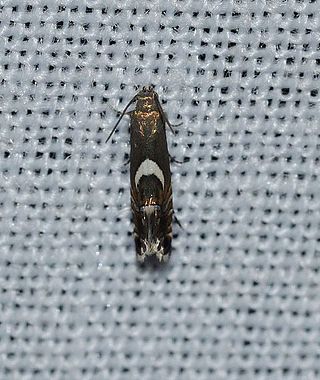
Agrotis segetum, sometimes known as the turnip moth, is a moth of the family Noctuidae. The species was first described by Michael Denis and Ignaz Schiffermüller in 1775. It is a common European species and it is found in Africa and across Eurasia except for the northernmost parts.
Numata is a genus of moth in the family Gelechiidae. It contains the species Numata bipunctella, which is found in North America, where it has been recorded from Texas.

Perispasta is a genus of moths of the family Crambidae. It contains only one species, Perispasta caeculalis, or Titian Peale's pyralid moth, which is found in North America, where it has been recorded from Quebec west to British Columbia, south to Florida, Texas and Colorado. The habitat consists of fields and meadows. Both the genus and species were first described by Philipp Christoph Zeller in 1875.

Chytolita is a monotypic litter moth genus of the family Erebidae erected by Augustus Radcliffe Grote in 1873. Its only species, Chytolita morbidalis, the morbid owlet moth or morbid owlet, was first described by Achille Guenée in 1854. It is found in large parts of North America, from coast to coast in the north and south to North Carolina, Texas and Florida in the west. The habitat consists of deciduous woods and edges.

Kocakina is a genus of moths of the family Noctuidae. It contains only one species, Kocakina fidelis, the intractable quaker moth, which is found in North America, where it has been recorded from Quebec and Maine to Florida, west to Texas and Kansas. The habitat consists of dry woodlands. The former genus name, Himella, is a junior homonym, and was replaced by Kocakina in 2006.

Eutrapela is a genus of moths in the family Geometridae. It contains only one species, Eutrapela clemataria, the curve-toothed geometer moth or purplish-brown looper, which is found in North America, where it has been recorded from Nova Scotia to Florida, west to Texas and north to Saskatchewan. The habitat consists of deciduous and mixed woodlands.
Euprora is a moth genus, belonging to the family Tineidae. It contains only one species, Euprora argentiliniella, which is found in the southern parts of the United States, including Texas and Florida.

Larisa is a genus of moths belonging to the subfamily Olethreutinae of the family Tortricidae. It contains only one species, Larisa subsolana, which is found in North America, where it has been recorded from Alabama, Florida, Georgia, Illinois, Indiana, Kentucky, Maine, Maryland, Massachusetts, Minnesota, Mississippi, Missouri, New York, Ohio, Oklahoma, Ontario, Quebec, South Carolina, Tennessee, Texas, Virginia, and West Virginia.
The Chrysopeleiinae are a subfamily of the Cosmopterigidae, although some authors treat it as a full family, the Chrysopeleiidae.

Diploschizia impigritella, the yellow nutsedge moth or the five-barred glyphipterid moth, is a species of sedge moth in the genus Diploschizia. It was described by James Brackenridge Clemens in 1862. It is found in North America, from Newfoundland to Florida, west to Texas and North Dakota. It has also been recorded from California.
Prorella desperata is a moth in the family Geometridae first described by George Duryea Hulst in 1896. It is found in the US states of Arizona and Texas.
Eupinivora ponderosae is a species of moth of the family Tortricidae. It is found in the montane regions of the western United States from Nevada, Utah, Wyoming and Colorado, south to Arizona and New Mexico and east to Texas. The habitat consists of conifer-dominated areas at elevations ranging from 1,700 to 2,700 meters.

Protorthodes texicana is a moth in the family Noctuidae first described by J. Donald Lafontaine in 2014. It is known from west-central Texas and southern Mexico.

Protorthodes ustulata is a moth in the family Noctuidae first described by J. Donald Lafontaine, J. Bruce Walsh and Clifford D. Ferris in 2014. It is found in North America from south-eastern Wyoming southward to the Guadalupe Mountains in western Texas and westward to central and south-eastern Arizona and northern Mexico.

Protorthodes alfkenii is a moth in the family Noctuidae first described by Augustus Radcliffe Grote in 1895. It is found in North America from central Oregon, southern Idaho, central Wyoming and north-western Texas southward to southern Mexico. The habitat consists of open arid woodlands.

Nudorthodes texana is a moth in the family Noctuidae first described by Smith in 1900. It is found in the US from the intermontane region of Washington, Oregon, Nevada and Utah southward to southern California and Arizona and southeastward to the Gulf Coast of Texas. The habitat consists of steppe regions, wet meadows and alfalfa fields.

Aroga trialbamaculella, the red-striped fireworm moth, is a moth of the family Gelechiidae. It is found in the United States, where it has been recorded from Maine to Florida and from Illinois to Texas.

Sciota uvinella, the sweetgum leafroller moth, is a species of snout moth in the genus Sciota. It was described by Ragonot in 1887. It is found in North America, where it has been recorded from New Jersey to Florida, west to Texas and Kentucky.

Doryodes spadaria, the dull doryodes moth, is a moth of the family Erebidae. The species was first described by Achille Guenée in 1857. It is found in North America, where it has been recorded from coastal Florida, Georgia, North Carolina, South Carolina and Texas. The habitat consists of salt marshes.

Neopalpa donaldtrumpi is a moth species of the genus Neopalpa occurring in Southern California and Northern Mexico. It was described in 2017 by Iranian-Canadian scientist Vazrick Nazari. Known for its yellowish-white head scales being reminiscent of Donald Trump's hair, the moth was given its name because Nazari stated that he wanted "to bring wider public attention to the need to continue protecting fragile habitats in the US that still contain many undescribed species."














